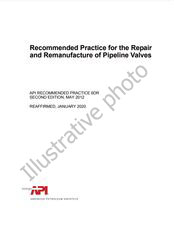We need your consent to use the individual data so that you can see information about your interests, among other things. Click "OK" to give your consent.

API PUBL 4599-ed.1994
Interlaboratory Study of Three Methods for Analyzing Petroleum Hydrocarbons in Soils
Translate name
STANDARD published on 1.6.1994
The information about the standard:
Designation standards: API PUBL 4599-ed.1994
Publication date standards: 1.6.1994
SKU: NS-1139771
The number of pages: 148
Approximate weight : 475 g (1.05 lbs)
Country: American technical standard
Category: Technical standards API
Annotation of standard text API PUBL 4599-ed.1994 :
API PUBL 4599, 1994 Edition, March 1994 - Interlaboratory Study of Three Methods for Analyzing Petroleum Hydrocarbons in Soils
1. SCOPE AND APPLICATION
1.1 Analytes
1.1.1 This method is designed to measure the concentration of diesel range organics in water and soil. This corresponds to an alkane range of C10 - C28 and a boiling point range between approximately 170°C and 430°C.
1.1.2 The method is designed to measure mid-range petroleum products such as diesel or fuel oil. Components greater than C28 present in products such as motor oils or lubricating oils are detectable under the conditions of the method. If, based on a review of the chromatogram, the presence of these product types is suspected, additional efforts may be performed including, but not limited to, analysis of additional reference materials. These additional efforts are not contained within this method.
1.2 Quantitation Limits
1.2.1 Quantitation limits are based on 100 µg/mL of diesel in the extract and are 0.10 mg/L for waters and 4.0 mg/kg for soils. (Note: The word "diesel" corresponds to diesel #2 or fuel oil #2.)
1.3 Dynamic Range
1.3.1 Dilutions should be performed as necessary to put the chromatographic envelope within the linear range of the method. In general, the individual compound range is 1.0 µ/mL to 50 µg/mL in the final extract. This is approximately equivalent to 100 µg/mL to 5000 µg/mL of diesel.
1.4 Experience
1.4.1 This method is based on a solvent extraction, Gas Chromatography (GC) procedure. This method should be used by, or under the supervision of, analysts experienced in the use of solvent extractions and gas chromatographs. The analysts should be skilled in the interpretation of gas chromatograms and their use as a quantitative tool.
We recommend:
Technical standards updating
Do you want to make sure you use only the valid technical standards?
We can offer you a solution which will provide you a monthly overview concerning the updating of standards which you use.
Would you like to know more? Look at this page.



 Cookies
Cookies
